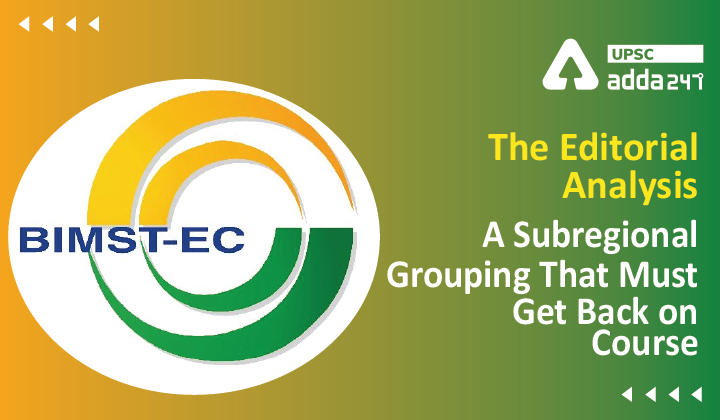Table of Contents
BIMSTEC UPSC: Relevance
- GS 2: Bilateral, regional and global groupings and agreements involving India and/or affecting India’s interests.
BIMSTEC summit 2022: Context
- Bay of Bengal Initiative for Multi-Sectoral Technical and Economic Cooperation (BIMSTEC) is going to be held in Sri Lanka, the current BIMSTEC chair.
संपादकीय विश्लेषण: एक उप क्षेत्रीय समूह जिसे मार्ग पर वापस आना चाहिए
What is BIMSTEC?
- BIMSTEC is a seven-member organisation that includes the littoral states of India, Bangladesh, Sri Lanka, Myanmar (Thailand is a member too) and the land-locked states of Nepal and Bhutan.
- It has 14 pillars for special focus: trade and investment, transport and communication, energy, tourism, technology, fisheries, agriculture, public health, poverty alleviation, counter terrorism and transnational crime, environment and disaster management, people-to-people contact, cultural cooperation and climate change.
Bay of Bengal Maritime Dialogue
- Recently, a Bay of Bengal Maritime Dialogue (BOBMD) was organised by the Centre for Humanitarian Dialogue and the Pathfinder Foundation.
- It had membership from Sri Lanka, India, Bangladesh, Myanmar, Thailand and Indonesia.
- The dialogue called for stepped up efforts in areas such as environmental protection; scientific research; curtailing illegal, unreported, and unregulated (IUU) fishing, as well as the development of standard operating procedures that could govern interaction between fishing vessels of one country with maritime law enforcement agencies of another.
Maritime resource of Bay of Bengal
- BOBMD highlighted that the Bay of Bengal is home to a large network of beautiful yet fragile estuaries, mangrove forests, coral reefs, sea grass meadows and mass nesting sites of sea turtles.
- However, it is matter of concern that the annual loss of mangrove areas is estimated at 0.4% to 1.7% and coral reefs at 0.7%.
- Moreover, it is predicted that the sea level will increase 0.5 metres in the next 50 years. The effect of which can be seen from the fact that there have been 13 cyclonic storms in the last five years.
- The Bay is an important source of natural resources for a coastal population of approximately 185 million people.
- According to the Food and Agriculture Organization of the United Nations (FAO), the Bay of Bengal is one of IUU fishing hotspots in the Asia-Pacific.
Issues in Bay of Bengal
- Emergence of a dead zone with zero oxygen where no fish survive;
- Leaching of plastic from rivers as well as the Indian Ocean;
- Destruction of natural protection against floods such as mangroves;
- Sea erosion;
- Growing population pressure and industrial growth in the coastal areas and consequently, huge quantities of untreated waste flow.
- Security threats such as terrorism, piracy and tensions between countries caused by the arrests of fishermen who cross maritime boundaries are additional problems.
BIMSTEC summit: What to be focussed?
- The BIMSTEC Summit must create a new regional mechanism for coordinated activities on maritime issues of a transboundary nature.
- This mechanism must initiate urgent measures to strengthen fisheries management, promote sustainable fishing methods, establish protected areas and develop frameworks to prevent and manage pollution, especially industrial and agricultural waste as well as oil spills.
- There is also a need for greater scientific research on the impact of climate change in general and on fisheries in particular. At present, there is limited cooperation between countries of the region in marine research.
- The use of modern technology and improved fishing practices can go a long way in restoring the health of the Bay.
BIMSTEC summit: Priority areas
- Marine environmental protection: It must become a priority area for cooperation in the Bay of Bengal by strengthening enforcement and sharing information on best practices.
- Regional protocols: These need to be developed, along with establishing guidelines and standards on pollution control.
- Home-grown solutions: There is a need for home-grown solutions based on capabilities of local institutions. Also, there is a need to create regional frameworks for data collection.
- Participatory approaches must be evolved for near-real-time stock assessment and the creation of an regional open fisheries data alliance.
- The BIMSTEC summit must express full support for both BOBP and BOBLME.
- The Bay of Bengal Programme (BOBP), an inter-governmental organisation based in Chennai, is doing good work to promote sustainable fishing.
- A Bay Of Bengal Large Marine Ecosystem (BOBLME) project is being launched by the FAO with funding from the Global Environmental Facility (GEF) and others.
- Curtail unsustainable fishing: The summit should come up with the measures to curtail unsustainable as well as IUU fishing. Steps could include:
- setting up an international vessel tracking system and making it mandatory for vessels to be equipped with automatic identification system (AIS) trackers;
- establishing a regional fishing vessel registry system and publishing vessel licence lists to help identify illegal vessels;
- increasing monitoring, control and surveillance in IUU fishing hotspots;
- establishing regional guidelines on how to deter and prevent IUU practices;
- improving the implementation of joint regional patrols, and regional fishing moratoriums and outreach programmes targeted at fisherfolk.
- Laws and policies in littoral states must be harmonised and the humanitarian treatment of fishermen ensured during any encounter with maritime law enforcement agencies.
BIMSTEC summit: Way forward
- The summit must set in process regular meetings to tackle illegal and unsustainable fishing as well as prevent the further environmental degradation of the Bay of Bengal.
Read current affairs for UPSC





 TSPSC Group 1 Question Paper 2024, Downl...
TSPSC Group 1 Question Paper 2024, Downl...
 TSPSC Group 1 Answer key 2024 Out, Downl...
TSPSC Group 1 Answer key 2024 Out, Downl...
 UPSC Prelims 2024 Question Paper, Downlo...
UPSC Prelims 2024 Question Paper, Downlo...




